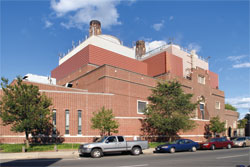The Climate at Yale
According to Yale University’s Climate Initiative (YCI), this Ivy League school in New Haven, Connecticut produced greenhouse gas emissions of 285,000 metric tons in 2002, more than 32 developing nations. Most of those emissions come from power plants, purchased power and on-campus buildings.

But things are looking up. In October 2005, Yale President Richard Levin announced the university’s commitment to reduce greenhouse gas emissions by 10 percent below its 1990 levels by 2020.
Achieving the school’s ambitious goal actually means a 44 percent decrease from current emissions levels. It was a timely intervention, because the university’s emissions were projected to increase 47 percent by the year 2020. But as Yale Senior Energy Engineer Tom Downing explains, a turning point was reached last year. “Yale’s emissions level actually decreased for the first time in 2005,” he says.
The administration challenged the students to reduce energy use in the residential colleges by 15 percent over the next three years. As an incentive, the school pledged to purchase renewable energy certificates equal to one third of the college’s remaining electricity budget for every five percent decrease in energy consumption. In the 2005-2006 school year, the students decreased their energy consumption by 10.2 percent. Julie Newman, director of Yale’s Office of Sustainability, says that the climate change program “has changed the way we think about energy at Yale.”
Students are encouraged to buy only Energy Star-certified appliances, a move that could eliminate 935,000 pounds of carbon dioxide (CO2) annually. The university is also doing a better job of monitoring its 50,000 steam traps, which send heat down the drain when they fail. A 40-kilowatt photovoltaic array is in place at the Divinity School.
In the “Light 4 Light” program, the Student Taskforce for Environmental Partnership handed out 2,000 compact fluorescent light bulbs to students in exchange for 60-watt incandescent bulbs. The program paid for itself with energy savings in four months. The Advisory Committee on Environmental Management also created the Green Fund, which provides grants to improve Yale’s environmental performance.
One noteworthy Green Fund grantee is the Algal Photo-Bioreactor Project led by a Yale senior, Katherine Rostkowski. “The project’s aim is to develop a sustainable CO2 removal technology,” she says. Fiber-optic cables will bring sunlight into the reactor to feed the algae. During photosynthesis, the algae will filter the CO2 out of the emissions from the Yale Central Power Plant, which runs on natural gas with a connected cogeneration system, she explains. Although the project is still in a laboratory test phase, Rostkowski says the reactor can be used to produce biodiesel to power the 18-megawatt plant.
In many ways, campus climate activism was launched on the Yale campus. Billy Parish, now of the Washington-based Energy Action Coalition, was a Yale student when he first tried to transform college energy use. Parish’s group has now teamed up with MTV to spread the campus gospel even wider (see E’s online Our Planet archives).

